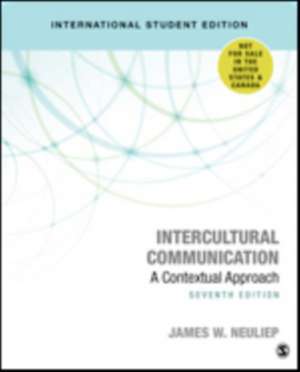Intercultural Communication: A Contextual Approach
Autor James W. Neuliepen Limba Engleză Paperback – 18 iul 2017
– Bin Zhang, PhD., South Puget Sound Community College
In the fully updated Seventh Edition of Intercultural Communication: A Contextual Approach, bestselling author James W Neuliep provides a clear contextual model (visually depicted by a series of concentric circles) for examining communication within cultural, microcultural, environmental, sociorelational and perceptual contexts.
He introduces the broadest context – the cultural component of the model – and progresses chapter by chapter through the model to the most specific dimensions of communication. Each chapter focuses on one context and explores the combination of factors within that context, including setting, situation and circumstances. Highlighting values, ethnicity, physical geography and attitudes, the book examines means of interaction, including body language, eye contact and exchange of words, as well as the stages of relationships, cross-cultural management, intercultural conflict and culture shock.
Preț: 470.12 lei
Preț vechi: 602.71 lei
-22% Nou
Puncte Express: 705
Preț estimativ în valută:
89.96€ • 94.12$ • 74.73£
89.96€ • 94.12$ • 74.73£
Carte disponibilă
Livrare economică 12-26 martie
Livrare express 26 februarie-04 martie pentru 44.28 lei
Preluare comenzi: 021 569.72.76
Specificații
ISBN-13: 9781506390710
ISBN-10: 1506390714
Pagini: 528
Dimensiuni: 187 x 232 x 31 mm
Greutate: 0 kg
Ediția:Seventh Edition (International Student Edition)
Editura: SAGE Publications
Colecția Sage Publications, Inc
Locul publicării:Thousand Oaks, United States
ISBN-10: 1506390714
Pagini: 528
Dimensiuni: 187 x 232 x 31 mm
Greutate: 0 kg
Ediția:Seventh Edition (International Student Edition)
Editura: SAGE Publications
Colecția Sage Publications, Inc
Locul publicării:Thousand Oaks, United States
Cuprins
Preface
A Note on Culture and Language
Chapter 1: The Necessity of Intercultural Communication
Chapter 2: The Cultural Context
Chapter 3: The Microcultural Context
Chapter 4: The Environmental Context
Chapter 5: The Perceptual Context
Chapter 6: The Sociorelational Context
Chapter 7: The Verbal Code
Chapter 8: The Nonverbal Code
Chapter 9: Developing Intercultural Relationships
Chapter 10: Intercultural Conflict
Chapter 11: Intercultural Communication in Business, Health Care, and Educational Settings
Chapter 12: Acculturation, Culture Shock, and Intercultural Competence
Glossary
Notes
Index
A Note on Culture and Language
Chapter 1: The Necessity of Intercultural Communication
Chapter 2: The Cultural Context
Chapter 3: The Microcultural Context
Chapter 4: The Environmental Context
Chapter 5: The Perceptual Context
Chapter 6: The Sociorelational Context
Chapter 7: The Verbal Code
Chapter 8: The Nonverbal Code
Chapter 9: Developing Intercultural Relationships
Chapter 10: Intercultural Conflict
Chapter 11: Intercultural Communication in Business, Health Care, and Educational Settings
Chapter 12: Acculturation, Culture Shock, and Intercultural Competence
Glossary
Notes
Index
Notă biografică
James W. Neuliep (Ph.D., University of Oklahoma) conducts research and teaches courses in intercultural communication, communication theory, communication apprehension, ethnocentrism, and research methods at St. Norbert College. In addition to his introductory intercultural communication textbook, he was also written an introductory communication theory textbook, and his research has appeared in many respected journals. He is the former editor of the Journal of Intercultural Communication Research and has served on the editorial boards of Communication Reports, Communication Research Reports, Communication Studies; International and Intercultural Communication, Journal of Communication; Journal of Applied Communication Research; Journal of Social Behavior and Personality; and Communication Quarterly.
Descriere
The Seventh Edition of this bestseller provides a clear contextual model (visually depicted by a series of concentric circles) for examining communication within cultural, microcultural, environmental, sociorelational and perceptual contexts.
